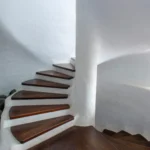Hanging heavy objects on plaster walls can be a daunting task, especially if you’re unsure of the proper technique to use.
However, with the right tools and knowledge, the process can be made much easier.
As someone who has hung many heavy items on plaster walls, I can attest to the fact that it is possible to do so without causing any damage to the wall.

The first thing to consider when hanging heavy objects on plaster walls is the type of wall you’re dealing with.
Plaster walls can vary in thickness and composition, and some are more fragile than others.
If you’re unsure about the strength of your wall, it’s important to do some research or consult with a professional before attempting to hang anything heavy.
One of the most important tools you’ll need for hanging heavy objects on plaster walls is a stud finder.
This will help you locate the wooden studs behind the plaster, which are the strongest part of the wall.
Once you’ve found the studs, you can use screws or nails to hang your heavy object securely.
If you’re unable to locate a stud, there are other techniques you can use, such as using a toggle bolt or molly bolt, but these are not as strong as attaching to a stud.
Understanding Plaster Walls
https://www.youtube.com/watch?v=03FpvpwAa3c&embed=true
As someone who has hung many things on plaster walls, I know firsthand that it can be a challenge.
Before we dive into the specifics of hanging heavy things on plaster walls, let’s take a moment to understand what plaster walls are and how they differ from other types of walls.
Plaster walls are made up of several layers of materials, including wooden lath, plaster, and sometimes a layer of wallpaper or paint.
The wooden lath is nailed to the wall studs, and then the plaster is applied over the top. This creates a strong and durable wall that can last for decades or even centuries.
One of the main challenges of hanging things on plaster walls is that they are not as strong as other types of walls, such as drywall or concrete.
Plaster walls can crack or crumble if too much weight is applied in one spot, or if the hanging hardware is not properly installed.
To avoid damaging your plaster walls, it is important to choose the right hanging hardware and to install it correctly.
Some of the best options for hanging heavy things on plaster walls include:
-
Screws with masonry anchors: These are a good choice for heavier items, as they provide a strong and secure hold. Be sure to choose anchors that are the right size for your screws, and to install them deep enough into the plaster to provide a solid hold.
-
Molly bolts: These are a good choice for medium-weight items, such as picture frames or mirrors. They are easy to install and provide a secure hold, but they can be difficult to remove if you need to take them down later.
-
Picture rail: If your plaster walls have a picture rail, this is the easiest and most secure way to hang things. Simply attach your picture wire or hanging hardware to the rail, and you’re good to go.
Tools and Materials Required

Identifying the Right Tools
When it comes to hanging heavy things on plaster walls, it is important to have the right tools on hand. Here are some tools that I recommend:
- Stud finder: This tool helps you locate the wall studs, which are the best parts of the wall to hang heavy items on.
- Drill: A drill is essential for making holes in the wall for screws and anchors.
- Screwdriver: You will need a screwdriver to drive screws into the wall.
- Level: A level helps you ensure that your items are hung straight.
- Pencil: A pencil is useful for marking where you want to hang your items.
Selecting Appropriate Materials
In addition to the right tools, you will also need to select appropriate materials. Here are some materials that I recommend:
- Screws: For lighter items, simply screwing into the plaster with a 1 1/4″ drywall screw is usually enough to get the job done. For heavier items, use screws with masonry anchors.
- Wall anchors: Wall anchors are essential for hanging heavy items on plaster walls.
- There are many types of wall anchors available, including toggle bolts, molly bolts, and plastic anchors. Choose the right type of anchor based on the weight of the item you are hanging.
- Picture hangers: If your plaster wall has a thin strip of wood running around the perimeter of the room, you can use picture hangers to hang lighter items. These hangers hook onto the picture rail and allow you to hang items without damaging the plaster.
Preparation Process

Before hanging heavy things on plaster walls, it is essential to prepare the wall to ensure its stability and safety. Here are the steps to follow:
Locating Studs
The first step is to locate the studs in the plaster wall. A stud is a vertical framing member used to support the weight of the wall.
To locate the studs, you can use a stud finder or a magnet.
A stud finder can detect the nails or screws that hold the lath to the studs, while a magnet can detect the nails in the lath that are connected to the studs.
To use a stud finder, turn it on and place it on the wall. Slowly move it horizontally until it beeps or lights up, indicating the location of a stud. Mark the location with a pencil.
If you don’t have a stud finder, you can use a magnet. Place a magnet on the wall and move it horizontally until it sticks to a nail in the lath. This indicates the location of a stud. Mark the location with a pencil.
Marking Drill Points
Once you have located the studs, the next step is to mark the drill points.
Mark the drill points with a pencil, using the stud locations as a guide. Make sure the drill points are level and evenly spaced.
If you are using a picture rail, you can mark the drill points on the rail instead of the wall. Make sure the drill points are evenly spaced and level.
Installation Process
https://www.youtube.com/watch?v=6CO2-4rTOs0&embed=true
Drilling the Holes
When hanging heavy objects on plaster walls, the first step is to drill the holes.
It is important to use the right drill bit size for the job. A 3/16-inch drill bit is recommended for most heavy objects.
Before drilling, it is important to locate the studs behind the plaster. This can be done by using a stud finder or by tapping the wall until you hear a solid sound, indicating the location of the stud.
Once you have located the studs, mark the spot where you want to drill the hole. Make sure the marks are level and evenly spaced.
Then, drill the holes using a slow, steady pressure. It is important to not apply too much pressure, as this can damage the plaster.
Securing the Fixtures
After drilling the holes, the next step is to secure the fixtures.
There are several options for securing fixtures to plaster walls, including toggle bolts, molly bolts, and picture hangers.
The type of fixture you choose will depend on the weight of the object you are hanging and the type of wall you are working with.
For heavy objects, toggle bolts or molly bolts are recommended.
These types of bolts are designed to spread the weight of the object across a larger area of the wall, reducing the risk of damage.
To use toggle bolts or molly bolts, insert the bolt into the hole and tighten it until it is snug. Then, insert the screw into the bolt and tighten it until it is secure.
For lighter objects, picture hangers can be used.
These hangers are designed to fit onto the picture rail that runs along the top of some plaster walls. Simply attach the hanger to the object you are hanging and then hang it on the rail.
Safety Measures

When hanging heavy things on plaster walls, it is important to take certain safety measures to prevent wall damage and avoid personal injury. Here are some tips to keep in mind:
Preventing Wall Damage
To prevent damage to your plaster walls, it is important to use the right tools and techniques. Here are some things to keep in mind:
- Use screws and anchors that are appropriate for the weight of the item you are hanging. If you are unsure of the weight, err on the side of caution and choose a heavier-duty option.
- Avoid using nails or tacks, as they can cause damage to your plaster walls and may not be strong enough to support heavy items.
- If possible, try to locate a stud in the wall to anchor your screws. This will provide extra support and reduce the risk of damage to your plaster.
Avoiding Personal Injury
When hanging heavy items on plaster walls, it is important to take steps to avoid personal injury. Here are some things to keep in mind:
- Always use a sturdy ladder or step stool when working at heights.
- Do not stand on furniture or other unstable objects.
- Wear appropriate safety gear, such as gloves and eye protection, when handling heavy items or power tools.
- Be careful when handling heavy items, and ask for help if you need it.
- Do not attempt to lift or move items that are too heavy for you to handle safely.






